These days downsizing is as common as flies at a summer picnic. Whether it’s urban sprawl and long commutes that have tempted you to move closer to the city center, or you are an empty nester who has developed a taste for a simpler life, you may find yourself with a diminutive outdoor space that challenges and confounds you. Consider simplicity as both your goal and your muse.
Let’s look at some design principles and examples so that you can turn your space into a sophisticated and peaceful retreat.
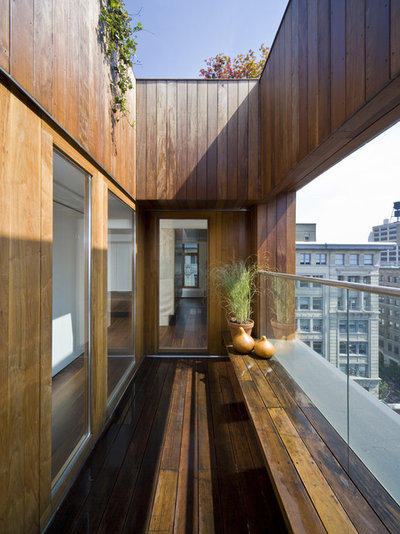
Zakrzewski + Hyde Architects
Start from the ground up to create an indoor-outdoor connection. A good first step is to consider your flooring, inside and out. After all, your terrace or courtyard can be viewed as an outdoor room and should be considered an extension of your home’s living space. In the case of the minimalist terrace shown here, the wooden flooring of the interior extends to the exterior, then similar wood extends up the wall, creating a homogenous, nurturing feeling.
In my home my flooring is a rich orange-brown Brazilian cherry. The adjoining deck sports a redwood stain with those same orange-brown tones. The interior flooring and exterior decking both run in the same direction. All of this creates a strong indoor-outdoor connection.
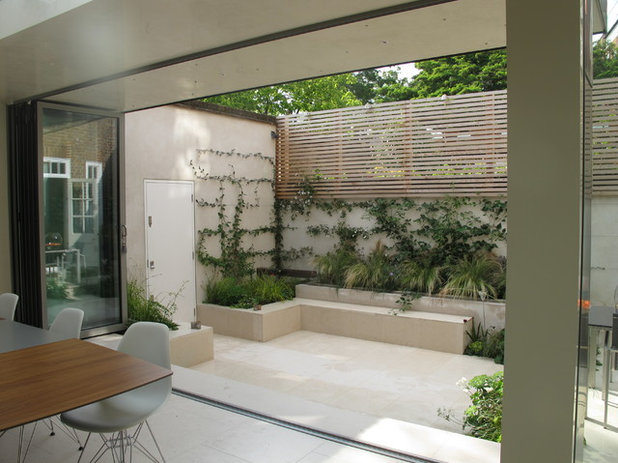
Charlotte Rowe Garden Design
Interior tile and stone flooring can often be continued outside, or an existing concrete slab patio can be scored and stained to match interior flooring. If carpet is your interior flooring choice, and you’re confident that you will live with it for years, consider laying patio stone to complement it or staining your concrete slab.
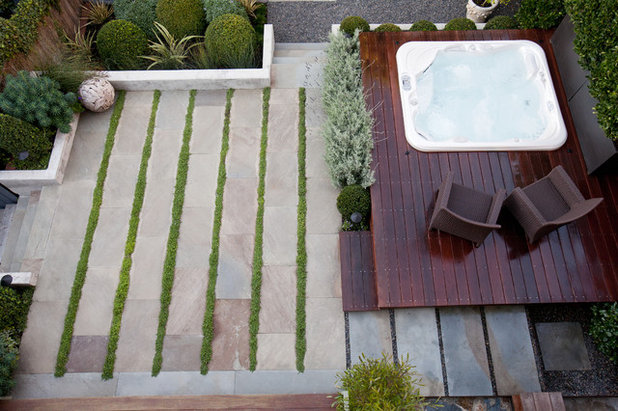
Katharine Webster Inc.
Consider interplanting your substrate with a low ground cover, such as mazus (
Mazus reptans, USDA zones 5 to 8; find your zone) or Elfin thyme (
Thymus serpyllum ‘Elfin’, zones 4 to 8). Doing so will bring interest to your outdoor room, not unlike a patterned rug.
See more ground covers that grow well between pavers
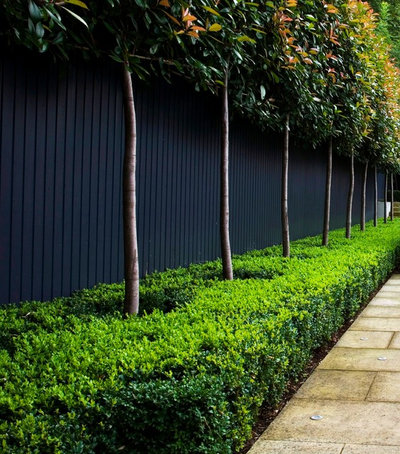
Laara Copley-Smith Garden & Landscape Design
Consider your garden walls. Historically, most gardens were walled for protection. Today we are even more protective of our shrinking real estate, laying claim to what is ours and sharing it with those who are important to us. Because of this, walled gardens remain popular.
I’m a big fan of black garden walls, especially in small spaces. Contrary to the popular opinion that dark walls make a space feel smaller, they can actually expand the space visually by fading into oblivion. If you are a doubter, look up at the night sky; you’ll see what I mean. Additionally, black walls can bring a crisp, sophisticated, contemporary or elegant vibe to your space. Dark green and chartreuse foliage, as well as white flowers, look their best against black walls.
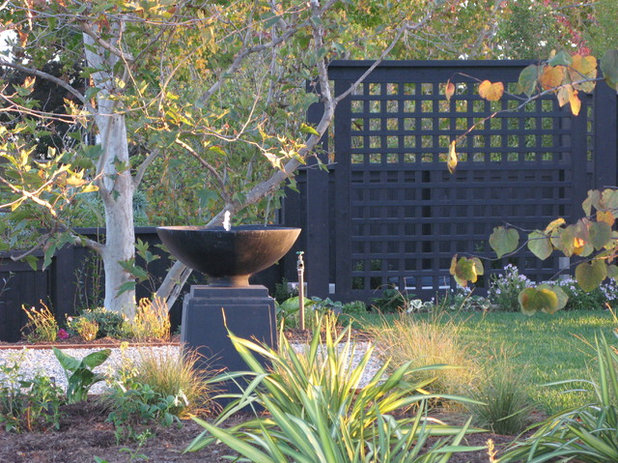
debora carl landscape design
If your garden walls cannot be changed, consider building one or more screens and painting them black to achieve the same look. Screens also cover a multitude of design sins, such as trash cans and HVAC units.
See more ways to use black outside
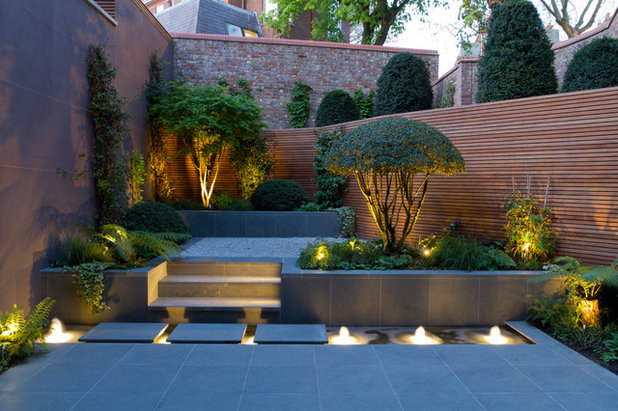
John Davies Landscape
Consider the run of your fencing, horizontal or vertical, because each brings a very different feeling to the space. Vertical fencing pulls the eye upward and can reduce perceived scale, making people feel smaller. Horizontal fencing creates a secure feeling of enclosure, rather like a hug. It also keeps the eye moving around the space, discovering new things.
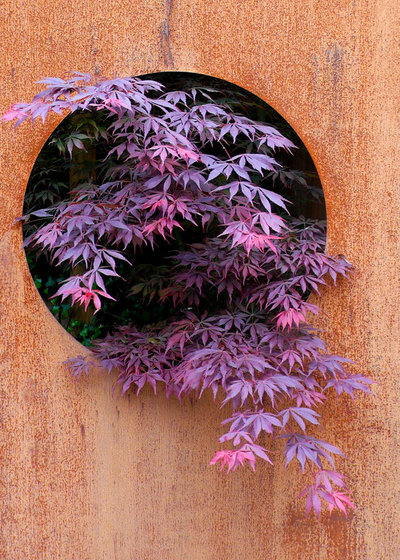
London Garden Designer
Add a window. Garden windows are portals to the world beyond. By thoughtfully placing them, you can let a small part of the outside world in on your terms, or provide a way to look out at it. If your garden wall consists of a large, dense hedge, consider cutting a window into it. Seek professional help before cutting into your hedge if you lack confidence and knowledge.

Charlotte Rowe Garden Design
Decide on a focal point. Your outdoor space needs and deserves a focal point, just as much as its interior counterpart. The focal point is the glue that holds the entire composition together. Its identity should be determined before any accessories are added, because those accessories are merely supporting actors in the production.
Your focal point should be roughly in scale with the size of your space, as is this narrow outdoor fireplace. However, a case may be made for going slightly larger, as it will then command more attention.
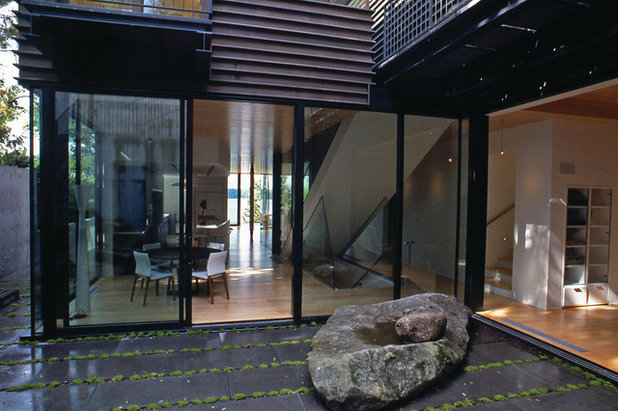
Robert Hutchison Architecture
You can employ a sculpture, a fountain or even a specimen tree as your focal point. This courtyard garden sports a boulder that brings a bit of natural hardscape into the space, providing organic contrast to the stone paving. Because its color is quite similar to that of the paving, it adds a three-dimensional quality. Your choice will be the stamp of individuality on your garden.
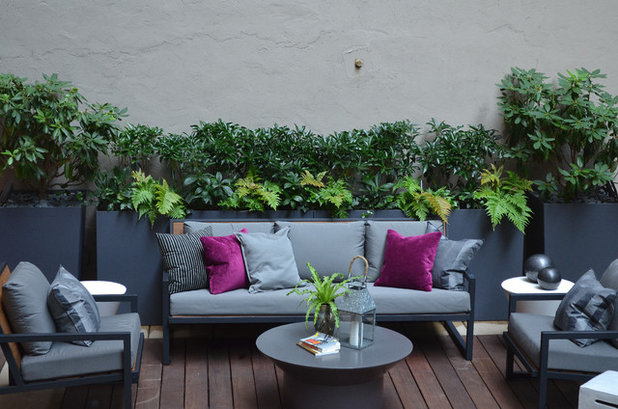
Jeffrey Erb Landscape Design
Bring in furniture. In a smaller courtyard garden, consider using a monochromatic scheme that you can, if desired, punctuate. Mixing vibrant colors and using bold patterns in tight spaces can actually make the space feel smaller, busier and less tranquil.
This terrace reads as a large and sophisticated space, without being stuffy, because the designer used a limited color palette. He then added fuchsia accents to pull the eye exactly to where he wanted it.
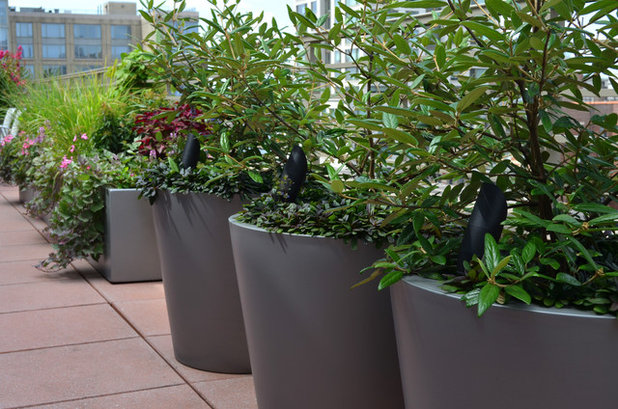
Jeffrey Erb Landscape Design
What about containers? In a small space, planters in the same hue and cast of the same material will create the illusion of a larger space. People often choose containers that have no common thread in an effort to spice up their spaces. Doing this generally leaves the space feeling fragmented and searching for identity. This is not to say that each container needs to be the same. Consider mixing shapes and sizes while maintaining the common thread of color and material. Additionally, the use of similar containers can bring rhythm to the space. Rhythm pulls the eye through the garden and helps the brain process it in a favorable manner.
Another common mistake is to choose containers that are too small. When in doubt, go a size or two larger. Your space will appear grander because of it, and your plants will thrive in the extra room.
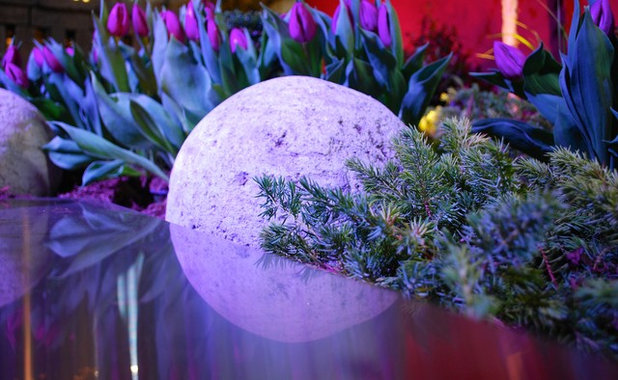
Jay Sifford Garden Design
The illusion of reflection. An intriguing garden is one that seems to be more than it is. Consider adding intrigue to your courtyard or terrace, and making it seem larger than it is, by introducing the element of reflection. Certain metals have a reflective quality and are useful as sublime finishes in the garden. The strip of stainless steel shown in this photo reflects and completes the shape of the stone sphere. (But be advised that metal can heat rapidly in the afternoon sun.)
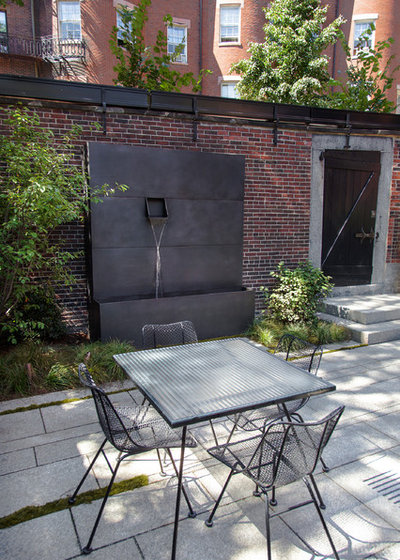
Matthew Cunningham Landscape Design LLC
Mask street noise with sound. Noise pollution could be called the urban theme song of our time. A serene urban garden is one that keeps outside noise at bay. The addition of moving water is the most common, and easily attained, solution to this issue.
Before deciding on a specific water feature, be aware that the volume of water flow, the length of the fall, and the depth and shape of the catch basin all determine the effectiveness in keeping unwanted noise outside your garden walls. That self-contained ceramic pottery unit from the nursery will provide very little positive sound for your space.
Have Your Garden Fountain and Be Water Wise Too
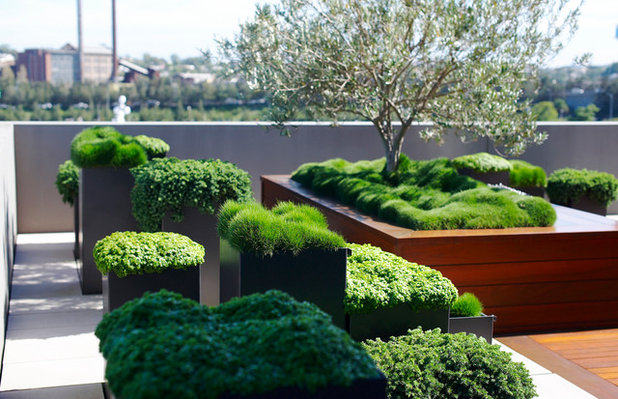
Secret Gardens
Choose your plant palette. Urban courtyards are frequently shaded, with neighboring buildings creating canyons and blocking sunlight. Rooftop gardens often experience harsh sunlight and may not be structurally designed for the heavy load of soil and trees. For these reasons it is important to choose your plant palette wisely. Always consult an engineer if you’re designing on or adding plant material to a roof.
This rooftop garden is an unexpected oasis with the lush artistic planting of mosses and ground covers. Additionally, the shape and placement of the planters forge a relationship with the wall.
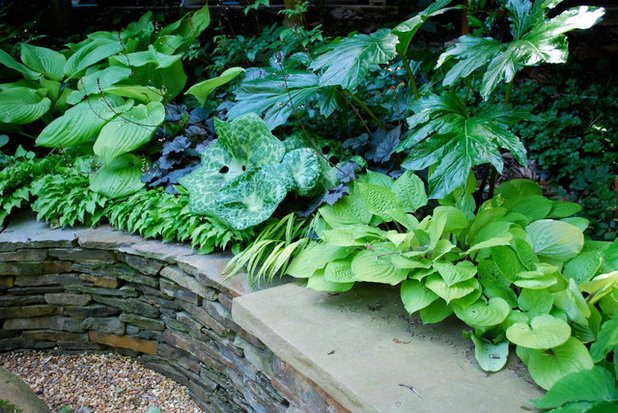
Jay Sifford Garden Design
If your courtyard garden is at ground level, you may be able to create planting beds instead of relying solely on containers. This will allow you to plant a wider variety of material. Careful selection based on cultural needs, sizes, shapes, foliage colors and textures will allow you to create a personal space.
Browse the Houzz section on garden foliage
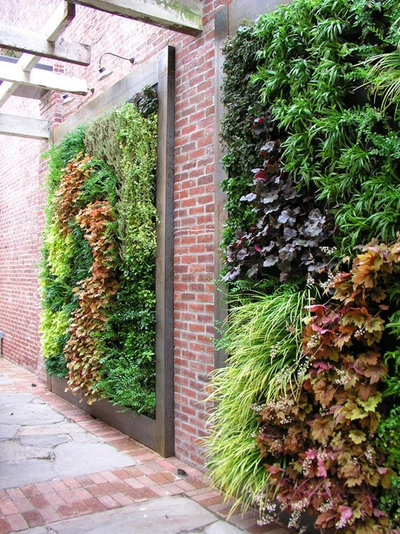
EcoWalls
Finally, you can usually go up, as is the case with this vertical garden. Again, pay close attention to cultural needs so that watering and maintenance requirements are similar in each section of your vertical garden. Don’t hesitate to employ help from a vertical gardening specialist.
Allow your inner artist expression by combining sizes, shapes, colors and textures in a unique way. And be sure to show us where your journey takes you.
Learn more about adding a living wall
More:Light Your Landscape for Drama and Function
Browse more Houzz guides to outdoor living





